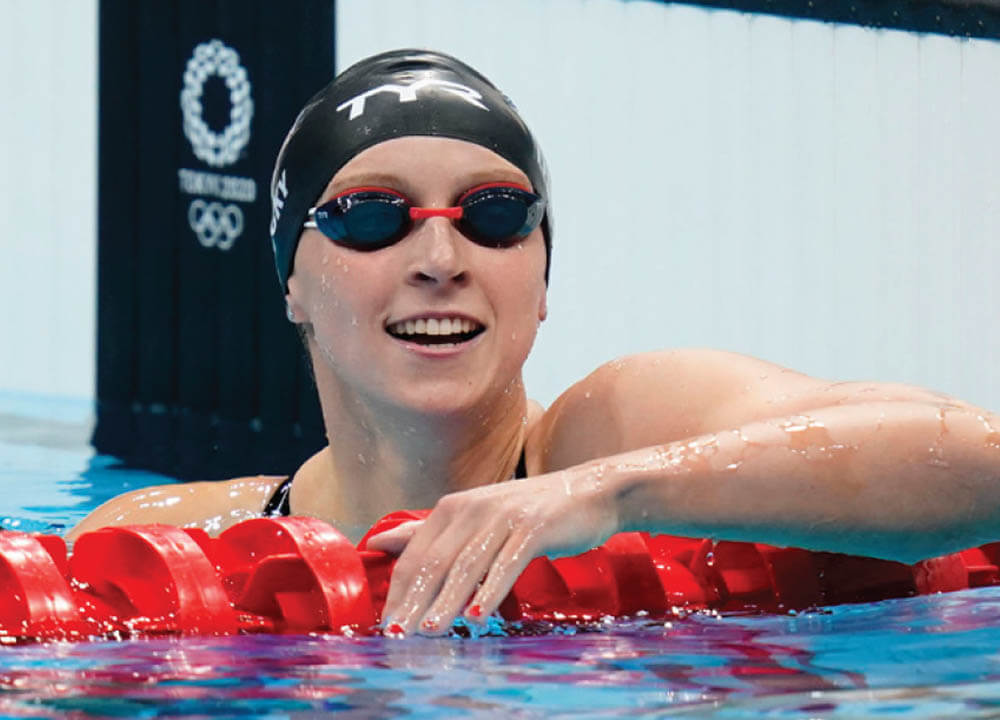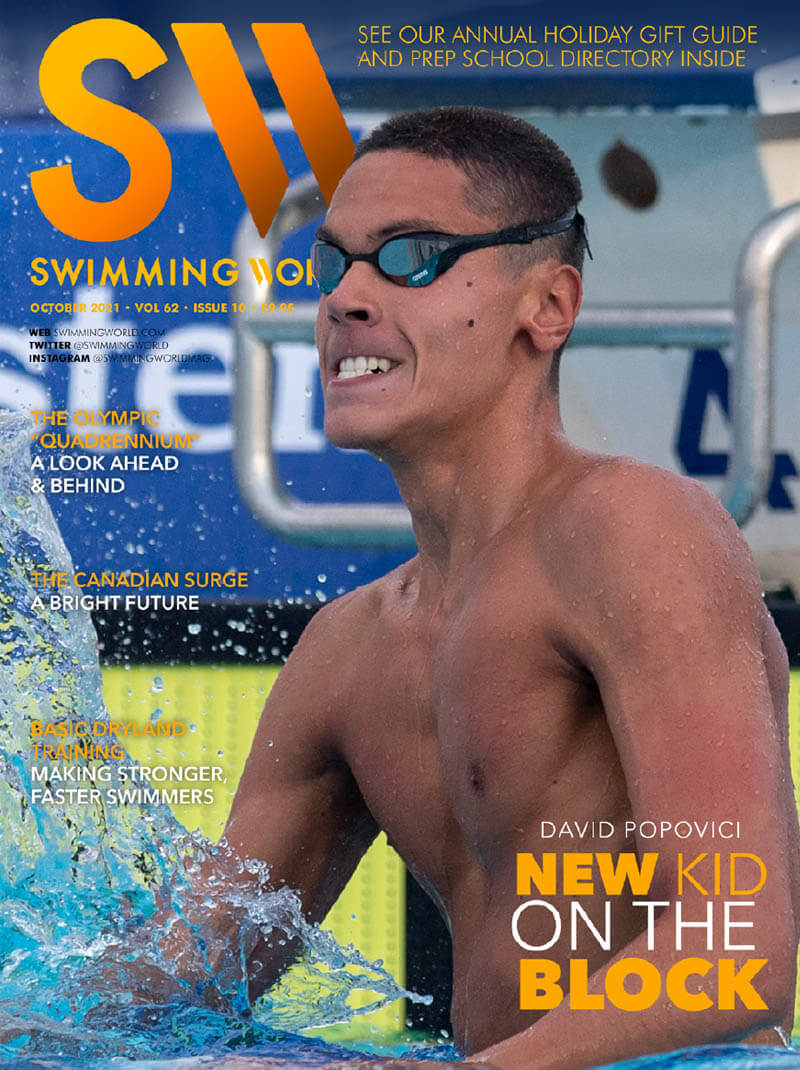Swimming World October 2021 Presents – The Olympic “Quadrennium:” Look Back And Look Ahead To Paris 2024

The latest issue of Swimming World Magazine
is now available for download in the Swimming World Vault!
Non-Subscribers Can Download This Issue Here
The Olympic “Quadrennium:” A Look Back And A Look Ahead To Paris 2024
By David Rieder
Swimming World reflects on the last five years since the last Olympic Games in Rio and ponders the questions that lie ahead during the next three years leading up to Paris 2024.
Five years ago, the swimming world had just watched as the sport’s all-time greatest, Michael Phelps, finished
his swimming career with another history- making performance. In Rio, Phelps was not at the level of the historic Beijing Olympics in 2008 where he won eight gold medals and set seven world records, but he recaptured gold in the 200 meter butterfly, his signature event, and won his fourth straight gold medal in the 200 IM (while no other man has ever even three-peated in an Olympics). He also was critical in three American relay gold medals. With Phelps retiring, the sport would certainly have a void to fill, the role of world’s best now up for grabs.
Today, there is 25-year-old Caeleb Dressel. Dressel bristles at comparisons to Phelps, and no swimmer deserves being compared to a man who won 28 Olympic medals, 23 of them gold. But Dressel’s emergence as the world’s best swimmer was the No. 1 story of the last five years, the “quadrennium” that became five years because of the COVID-delayed Olympic postponement from 2020 to 2021.
The first major meet after the Rio Olympics, the 2017 World Championships, saw Dressel tie Phelps’ record with seven gold medals at one Worlds, including three on one night. Dressel benefited from some relay events added to the program, but his haul was stunning and impressive, nonetheless.
Two years later, Dressel won eight medals (six gold and two silver) at Worlds, setting the all-time record. But his biggest moment would come at the showcase of the Olympic Games in Tokyo, and he delivered there, too. He won three individual gold medals—in the 100 freestyle, 100 butterfly and 50 freestyle—to become just the third man after Phelps and Mark Spitz to win more than two individual golds in one Olympics. He lowered his world record in the 100 fly and led two American relays to gold medals.
At least on the men’s side, Dressel is the new face of swimming. No, he is not Phelps, and he will never be—not just because he specializes in sprints while Phelps was more of a 100/200 swimmer. But like Phelps, Dressel is versatile and dominant in multiple events, and he has shown a knack for putting forth his best performances while in the brightest of spotlights.
THE WOMEN FROM DOWN UNDER DOMINATE
At the end of the last Olympics, Katie Ledecky was the world’s dominant swimmer, having become just the second female swimmer ever to capture gold in the 200, 400 and 800 freestyle in one Olympics, the latter two performances coming with massive world records. Over the next five years, Ledecky would never again reach that level of dominance or speed, but she has remained one of the world’s best.
In Tokyo, she swam the second-best performance of her career in the 400 free as she brought home a hard-fought silver medal, and then, just over an hour after finishing a disappointing fifth in the 200 free, she became the first-ever female gold medalist in the 1500 free. She then used a brilliant anchor leg on the 800 free relay to elevate the Americans to silver before winning her third straight gold medal in the 800 free, becoming just the third woman (along with Dawn Fraser/100 free and Krisztina Egerszegi/200 back) to three-peat in any race.
But the biggest story of the Tokyo quad for the women took longer to develop. At the past two Olympics, Australia had entered the Games with gold medal threats, particularly in 2016, only to finish with very underwhelming medal tallies. In 2021, three Australians looked like gold-medal favorites in multiple individual events, and all three of them came through.
First, there was the pair of 20-year-olds. Ariarne Titmus was the swimmer who took down Ledecky in the 400 free, recording the second-fastest time in history and just missing Ledecky’s world record in the process, and she also was impressive in winning gold in the 200 free, just a month after recording history’s second-fastest time. Meanwhile, Kaylee McKeown had recorded scorching backstroke swims seemingly every time she raced since November, and she broke the 100 back world record in June. In Tokyo, she scored gold medals three times—in the 100 back, 200 back and as part of Australia’s 400 medley relay.
The Games’ star, however, was Emma McKeon, a long-overshadowed sprinter who won seven medals, more than any female swimmer ever at one Olympics. She took home individual gold medals after dominant wins in the 100 freestyle and 50 freestyle—approaching world records in both—and she was the best swimmer on two golden Australian relays, the 400 free and 400 medley. She also won three bronze medals. McKeon had shown talent and versatility and particular aptitude for fast relay swims time after time over her elite international career, which stretches back to 2013, but her emergence as the best swimmer in the world was less expected.
To read more about the stars of previous Olympic Games as we all look toward Paris 2024,
Click here to download the full October issue of Swimming World Magazine, available now!
 [PHOTO BY GEORGIO SCALIA / DEEPBLUEMEDIA]
[PHOTO BY GEORGIO SCALIA / DEEPBLUEMEDIA]
Get Swimming World Magazine and Swimming World Biweekly FREE When You
Become A Member of the International Swimming Hall of Fame
New! 30 Day Membership to ISHOF AND Digital Swimming World Subscription for just $10 a month!
Want more? Get a 1 Year ISHOF Family Membership With Swimming World Print AND Digital Subscription Order Now!
Non-Subscribers can click here to download this issue for only $5.94
FEATURES
010 THE OLYMPIC “QUADRENNIUM:” A LOOK BACK AND A LOOK AHEAD
by David Rieder
Swimming World reflects on the last five years since the last Olympic Games in Rio and ponders the questions that lie ahead during the next three years leading up to Paris 2024.
014 A CANADIAN SURGE
by Matthew De George
Swimmers from Canada exceeded expectations at the Tokyo Games. And the Canadian delegation showed that the future is as bright as the present, with prolific young talents on both sides of the competition.
020 ISHOF FEATURE: AQUATOTS MURDER CASE—THE KATHY TONGAY STORY (Part 1)
by Bruce Wigo
It is doubtful that in the annals of aquatic history, there has ever been an example of abusive parents like the story of “little Kathy Tongay.”
024 EXPECT GREAT THINGS!
by John Lohn
David Popovici just turned 17 years old, but the Romanian sprint freestyler appears poised to follow a path to prominence.
031 NUTRITION: KNOW THYSELF
by Dawn Weatherwax
Knowing your body composition can help you swim fast and stay healthy.
COACHING
029 BASIC DRYLAND TRAINING
by Michael J. Stott
A concentrated, ongoing strength and conditioning regimen provides a quality supplement to in-pool training, helping swimmers become stronger and faster. Coaches Ron and Rich Blanc of Santa Margarita Catholic High School in Southern California share last season’s dryland training schedule that helped his girls’ and boys’ teams become national powers.
030 WEIGHT ROOM COMMON SENSE
by J.R. Rosania
These “Do’s and Dont’s” are courtesy of exercise scientist J.R. Rosania, whose performance enhancement firm Healthplex serves multisport athletes worldwide.
034 SWIMMING TECHNIQUE CONCEPTS: MAXIMIZING SWIMMING VELOCITY (Part 5): MINIMIZING THE ARM RECOVERY PHASE
by Rod Havriluk
The greatest possible time decreases for additional swimming velocity increases are in the non-propulsive phases (entry and recovery). This article includes strategies to minimize the recovery phase time of all four strokes.
045 Q&A WITH COACHES RON & RICH BLANC
by Michael J. Stott
046 HOW THEY TRAIN MAGGIE McGUIRE & JACK NUGENT
by Michael J. Stott
TRAINING
033 DRYSIDE TRAINING: BACK TO BASICS (Part 1)
by J.R. Rosania
JUNIOR SWIMMER
044 UP & COMERS: MARYJANE (MJ) NEILSON
by Shoshanna Rutemiller
COLUMNS & SPECIAL SECTIONS
008 A VOICE FOR THE SPORT
009 DID YOU KNOW: ABOUT FAMOUS GUYS WHO GOLF?
016 HOLIDAY GIFT GUIDE
036 PREP SCHOOL DIRECTORY`
048 GUTTERTALK
049 PARTING SHOT
Swimming World is now partnered with the International Swimming Hall of Fame. To find out more, visit us at ishof.org



